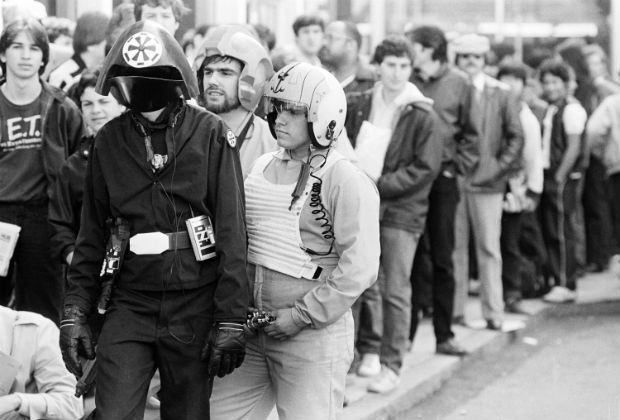As ‘Star Wars’ returns, a new generation quakes

In this May 25, 1983 file photo, three costumed fans of the “Star Wars” movie trilogy, Kevin Maguire, from left, as an Imperial Fire Control Officer, Stephen Robards, and his brother John Robards as Rebel Fighter Pilots, stand in a line of ticket buyers outside a Boston theater, before the first showing there of the film “Return of the Jedi.” The effect “Star Wars” has had on movies is as colossal as the Death Star itself and to some, just as fearsome. The new movie, “Star Wars: The Force Awakens,” opens in U.S. theaters on Dec. 18, 2015. AP
NEW YORK — Long before I was a movie writer and critic, I was a teenager driving up the Garden State Parkway in a Storm Trooper helmet, inquiring toll booth attendants if they had seen two droids.
I don’t know what this means for my relationship with “Star Wars” and the coming sequel, “The Force Awakens,” which is some mix of boyish excitement and adult despair. I do know that it’s difficult to operate a stick shift with a Storm Trooper helmet on and that New Jersey toll booth attendants are a hard bunch to faze.
As “The Force Awakens” makes its way into theaters, moviegoers and critics of generations old and young will again have to wrestle with a cultural force as colossal as the Death Star, whose cinematic firepower is alternatively seen as the vile source to today’s franchise-mad blockbuster-crazy Hollywood or the ultimate expression of a glorious movie passion that spans time, galaxies and dreadfully disappointing prequels.
For a fairly impersonal epic of corny characters, “Star Wars” inspires curiously personal reactions. It drives some people to don Wookiee costumes and others to curse an entire industry as infantile. Since the 1977 debut of “A New Hope,” it’s become a generational rite of passage not just to experience the saga, but also to form one’s relationship with movies around it, whether in happy lockstep or rebel opposition.
“‘Star Wars’ made, and changed, movie and cultural history, and anybody who wants to make sense of either has to take it on,” wrote critic Glenn Kenny in “A Galaxy Not So Far Away: Writers and Artists on Twenty-Five Years of Star War.”
Article continues after this advertisement“Star Wars” didn’t, by itself, change movies. But more than any other film, it heralded the blockbuster era that would follow the maverick filmmaking of the ’70s __ a continuing chapter in movies that swells with every new superhero movie.
Article continues after this advertisementREAD: ‘Star Wars’–with Han Solo–returns
Lucas, himself, straddled the divide he came to be the poster boy of. Coming off the success of “American Graffiti,” which he wrote, his pal Francis Ford Coppola wanted him to direct “Apocalypse Now.” (Take a moment to contemplate THAT parallel universe.) Lucas was instead busy with his script for “Star Wars,” a project that few expected much of and that Universal Studios passed on before 20th Century Fox paid Lucas to develop it.
But to the astonishment of everyone, including Lucas (who fortuitously negotiated for the sequel and merchandising rights), the movie he called “‘The Sting’ in outer space'” was a smash that was still No. 1 at the box office more than 40 weeks after opening.
Many critics watched its rise warily. Pauline Kael called the movie “a box of Cracker Jacks which is all prizes.” John Simon fretted: “O dull new world!”
All the profits fueled the multiplexes erected through the 1980s. Their walls would blare with Lucas’ own sound system, THX, and play countless action sequences designed by Lucas’ effects house, Industrial Light and Magic.
Many of the forces Lucas unlocked __ the merchandizing power, the franchise building, the super-fandom __ now define the modern movie business. Paul Schrader, writer of 1976’s “Taxi Driver” and 1980’s “Raging Bull,” once called “Star Wars” ”the film that ate the heart and soul of Hollywood.”
“Star Wars,” though, was part of a broader and perhaps unstoppable trend. It followed James Bond films and Steven Spielberg’s “Jaws” (the first movie to open in wide release). “Superman: The Movie” arrived the year after.
“The Force Awakens” now finds itself in a more competitive blockbuster environment, just one of the prime assets in the stable of the Walt Disney Co., which purchased Lucasfilm for $4.05 billion — a fitting home for “Star Wars” considering Lucas considered it “a Disney movie.”
READ: IN PHOTOS: Interactive ‘Star Wars’ exhibit opens at SM Mall of Asia
Inheriting Lucas’ empire, director J.J. Abrams — one of those kids transfixed by “Star Wars,” now grown up — isn’t trying to redefine moviegoing. His “The Force Awakens” is more like a restoration project: a blend of new and old; old-school special effects with a more diverse cast. Alongside the old guard of Han Solo and Luke Skywalker, the new characters are effectively stand-ins for new fans.
“It was the idea of what would this new generation be, given that they were standing on the shoulders of characters we knew from years earlier,” Abrams said in an earlier interview. “How their history is the history that we know.”
“Star Wars” ultimately belongs to the young. The saga’s new chapter will be written by a franchise-savvy generation of moviegoers who can pre-order tickets without standing in line, and critics who grew up in the shadow of “Star Wars” __ some of whom even know how fast Han Solo can make the Kessel Run.
“12 parsecs!” exclaims this one, with more pride than shame.